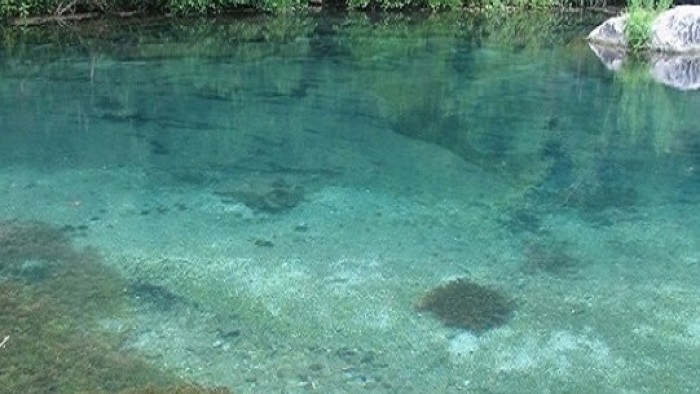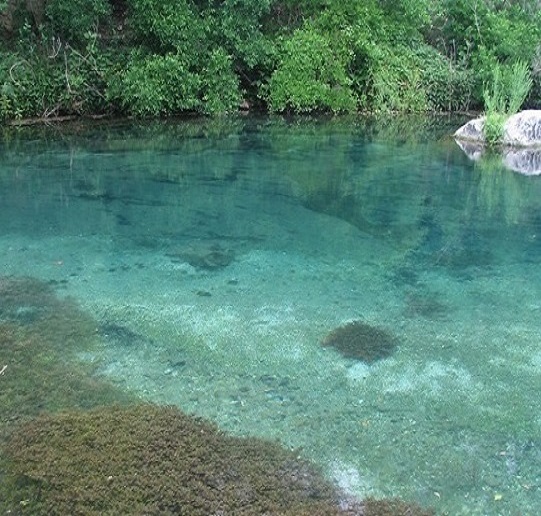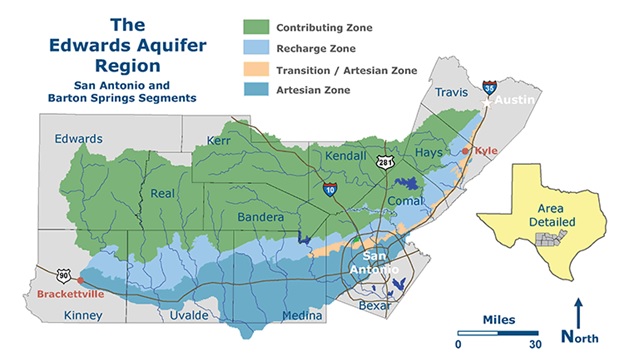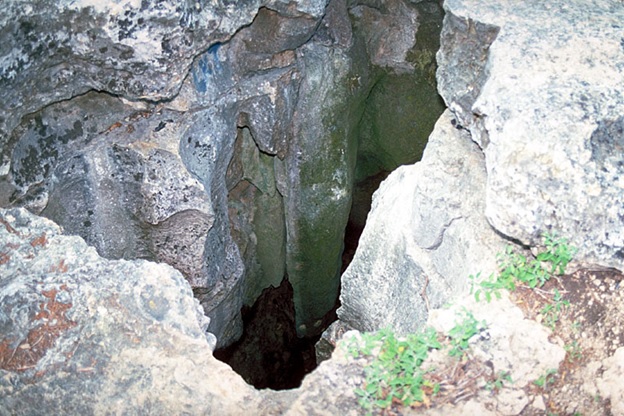San Antonio Provides Financing for Source Water Protection


Source: Edwards Aquifer
Since 2000, residents of San Antonio, Texas have voted four times to approve ballot measures setting aside a portion of local sales-tax revenue for the city’s Edwards Aquifer Protection Program (EAPP). The Nature Conservancy’s (TNC) January report “Beyond the Source: The Environmental, Economic and Community Benefits of Source Water Protection” showcases San Antonio’s program as an example of a publicly financed water fund. Water funds are institutional platforms that connect upstream and downstream users through the financing, governance and management of source water protection.
The four ballot measures passed by San Antonio voters authorized bond offerings to provide upfront financing for the aquifer-protection program. These bonds are repaid with funds set aside from local sales-tax revenue. This financing provides the City with upfront capital to quickly protect land atop the Edwards Aquifer, some of which is facing immediate development pressure. A total of $315 million has been raised since 2000.
In addition to protecting water quality and quantity, the EAPP provides many peripheral benefits. These include habitat and endangered species protection, climate change mitigation, recreational opportunities, and air quality.
The Need for Protection
San Antonio sits atop the Edwards Aquifer, an artesian aquifer that spans more than 4,000 miles and 12 counties in central Texas, according to the report. Laura Huffman, state director of TNC Texas, described the aquifer as “a giant sponge…that captures and holds water and treats it for pollutants.” The aquifer recharges as rainwater filters through fractures, caves and sinkholes formed in the region’s primarily limestone bedrock.
According to the report the Edwards Aquifer supplies drinking water for approximately two million people, including residents of San Antonio. It also supports industrial and agricultural uses. Grant Ellis, natural resources manager at the City of San Antonio, said “San Antonio is uniquely situated [because] the majority of [the city’s] drinking water comes from one source that doesn’t have to be treated that much.”
However, San Antonio, which is currently the nation’s seventh largest city, is growing fast. According to the Texas Demographic Center, Bexar County, which includes San Antonio, could more than double in population by 2050. This growth is accompanied by development pressures that put the city’s primary water source at risk. The aquifer is susceptible to contaminating pollutants from human activities. In addition, its rate of replenishment is affected by the construction of impermeable surfaces like pavement.

The Creation of a Water Fund
In the late 1990s, elected officials and nonprofit leaders with concerns about the future of San Antonio’s water supply came up with the idea of a publicly financed water fund. In 2000, the City Council added a sales tax initiative to the ballot with the goal of raising funds for aquifer protection. More than 50 percent of voters chose to put one eighth of a cent of local sales tax towards repaying bonds issued to fund source water protection. This initial effort raised $45 million.
In 2005, 2010 and 2015, similar ballot measures were approved by increasingly large percentages of voters. In total, these three measures raised $280 million to protect the aquifer. Ellis said San Antonio has a “dedicated funding source for aquifer protection as long as the sales tax is active and City Council continues to put it on the ballot.”
Ballot measure funding allows the city to quickly employ the most direct strategy available to protect water quality and quantity – protection of the land above the Edwards Aquifer. Protecting land ensures future water security and minimizes treatment costs through the preservation of natural infrastructure. Since 2000, approximately 146,000 acres of land above the aquifer have been protected through the EAPP. According to the report, this includes 21 percent of the aquifer’s recharge zone.
Ellis said that in most cases the city uses funds to purchase properties’ development rights by placing conservation easements on privately owned land. These easements are held and monitored by the city. They require landowners to “maintain property in its natural state” in perpetuity. In some cases, the city purchases parcels outright. However, purchasing development rights through easements is the city’s preferred strategy, Ellis said, because it provides the “best bang for the buck.”
While awareness and support for the program has grown over the last 17 years, Ellis said that “in the early days, some landowners were really reluctant to work with us.” Reluctance stemmed from mistrust of government as well as from a lack of familiarity with the city’s program and conservation easements as a mechanism of protection.
To skirt landowners’ wariness of government, the city now contracts with two NGOs, The Nature Conservancy Texas and Green Spaces Alliance, to interface with landowners as the program’s land-acquisition team. Staff from these organizations act as brokers between landowners and the city. They have a strong record of success persuading landowners to place easements on their properties. After almost 20 years of work, Ellis said, “it’s a much easier [idea to] sell. We’ve been so successful that now landowners call us because they hear about the program from their neighbors.”
In addition to praising the work of many individuals and organizations, Ellis and Huffman both attribute the sustained success of the program to San Antonians’ high awareness of the Edwards Aquifer as an important resource. Ellis said that “local news says what the aquifer level is every night and billboards flash it around town.” In addition, there are a number of youth-education programs offered by the city and local nonprofits.
TNC has also played an active role in building and sustaining support for EAPP. Staff members conduct polling prior to each election cycle to ensure that ballot measures appear on the ballot, and that initiatives pass once they are on the ballot. Huffman said TNC also “uses science to make sure that money is spent in the right places,” such as aquifer-recharge zones and other ecologically sensitive areas.

recharge feature for the Edwards Aquifer.
Source: Edwards Aquifer
Impacts of Source Water Protection
According to the report protection efforts have led to lower bacteria concentrations in streams draining into the aquifer-recharge zone. Levels of nitrogen, phosphorus, lead and zinc have also decreased.
In addition to protecting water quality and quantity Huffman noted that there are many “stacking benefits” associated with the program. Biodiversity improvements, species protection, climate mitigation, air quality, and public recreation are all examples.
Replication of the Model
Huffman believes that water funds are highly replicable all over the world. “People tend to overcomplicate the language in conservation, but the answer is always ‘yes’ if you ask people whether they want to protect water.”
To implement similar programs elsewhere, Huffman said, the starting point is to “identify a public or private revenue stream and build public support.” While this takes different forms depending on context, she said she believes water funds are “a good match for local governments.” Since cities are responsible for providing citizens with clean drinking water, Huffman said establishing water funds should be “an easy sell.”
When it comes to building public support, Huffman said it’s “important to avoid talking about [water funds] as single-dimension conservation strategies.” Instead, touting the benefits of open space, biodiversity protection, or regional character can help to cultivate buy-in. “You want to talk about conservation as well as infrastructure. Stacking benefits are part of an important story for conservation.”
“You also don’t want this to be a conservation organization’s isolated strategy, it needs to fit into a broader awareness strategy,” Huffman said. Getting officials, businesses and media on board and talking about the idea can reap huge dividends. “If you’re acting alone, it won’t be the best or most scaled work possible.”
Huffman said sustained long-term success “lies in the institutionalizing of the program and investment.” Embedding programs into institutions’ normal work and building public support over time can make programs like EAPP less vulnerable to shifts in leadership and surrounding conditions.
To comment on this article, please post in our LinkedIn group. You may also contact us via Twitter.